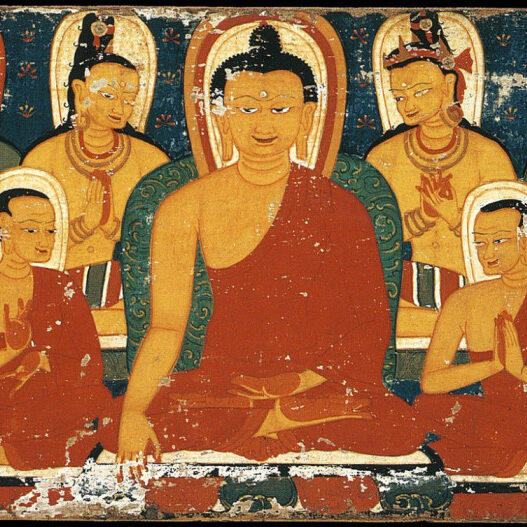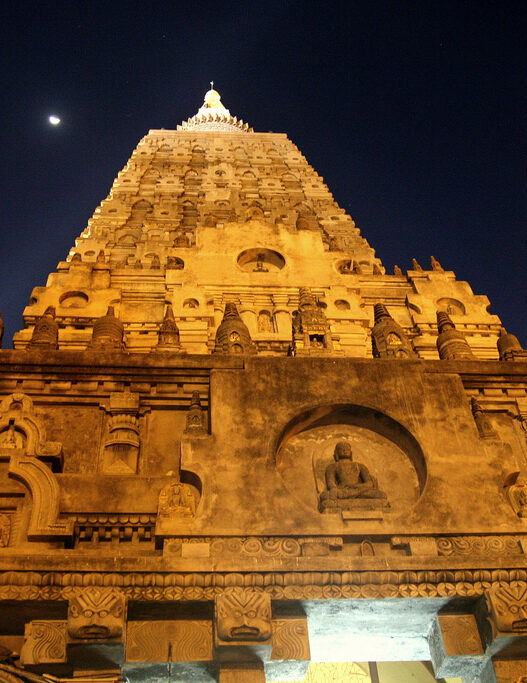This third course of the ACI In-Depth Course Series presents the entire section on the practice of exchanging self and others, which is a large part of the chapter on meditation (Chapter Eight) from The Guide to the Bodhisattva’s Way of Life (Bodhisattvacaryāvatāra, Byang-chug sems-dpa’i spyod-pa la ‘jug-pa), by Master Shantideva (c. 700 AD). This course is meant to give much more detail on this subject than the related original ACI course, Guide to the Bodhisattva’s Way of Life, Part Two (ACI Course XI), which covered only about half of this section on exchanging ourselves and others.
The reading material for this course consists of the 84 relevant verses of Master Shantideva’s root text, and includes both the original Sanskrit and the Tibetan translation of these verses. Following a pattern of the ACI Foundation Courses as we go deeper now with the in-depth courses, we will be taking a closer look at the original Sanskrit versions of the root texts.
Our goal will be to glean more of the original feel of the Buddhism taught in the land of its birth, India, in a language—Sanskrit—which is directly related to modern languages like English that many of use. And so we will be taking a special interest in places where checking the original Sanskrit wording gives us insights that we may miss out on if we utilize only the Tibetan translation.
For our basic English translation and interpretation of each verse, we will continue to rely heavily upon the extraordinary commentary written by Gyaltsab Je Darma Rinchen (1364-1432), the eminent disciple of Je Tsongkapa who became the first holder of his throne after the Teacher passed on. This commentary is called Entry Point for Children of the Victorious Buddhas (rGyal-sras ‘jug-ngogs.
With this course though we will also be using perhaps the most important commentary from ancient India upon Master Shantideva’s work. This is The Commentary to Difficult Points in the “Guide to the Bodhisattva’s Way of Life” (Bodhicaryāvatāra Pañjikā, Byang-chub kyi spyod-pa la ‘jug-pa’i dka’ ‘grep), composed by the Indian pandit Prajnyakara Mati (Prajñākaramati, or Shes-rab ‘byung-gnas blo-gros in Tibetan). The literal meaning of this author’s name is “The Intelligent One, the Source of Wisdom.”
His explanation of our root text was of course written in Sanskrit; it was translated into Tibetan about a thousand years ago, and is found in the Tengyur collection of ancient commentaries to the word of Lord Buddha. It seems to have been one of the primary sources used by Gyaltsab Je for his own commentary. Because it was composed in part as a “word commentary,” in the original Sanskrit, it sheds substantial new light on the meaning of Master Shantideva’s text.
Please note! Master Shantideva’s text, which is included in full in this reading, sounds easy to understand—but it’s not. We strongly encourage you to read these verses in conjunction with listening to the audio explanation, or even better attend a course (such as those sponsored by ACI) where the verses are explained by a qualified teacher.
As with so many of the ancient Indian writers, our information about Prajnyakara Mati’s life is scarce. Aside from his explanation of Master Shantideva’s classic, he also composed a brief explanation of The Ornament of Realizations of Lord Maitreya—a text on the perfection of wisdom which forms the basis for several ACI courses. This work is also found in the Tengyur, and was translated by Ngok Londen Sherab, who was one of the teachers of Geshe Drolungpa, the author of The Great Book on the Steps of the Teachings (bsTan-rim chen-mo: the Tenrim Chenmo).
At least one catalog to the Tengyur also contains a reference to a commentary by Prajnyakara Mati on The Letter to a Student, composed by the early Indian master Chandragomin. This teacher’s works also include an explanation of the bodhisattva vows that was used for the ACI course on the subject. The catalog goes on to make a special note here that Prajnyakara Mati wrote his commentary “out of a desire to benefit his own students.”
We do read in numerous sources that Prajnyakara Mati was one of the six gatekeepers of the famous Indian Buddhist monastery of Vikramalashila, and that he shared this duty with none other than the illustrious Naropa. Naropa is said to have watched the northern gate, and Prajnyakara Mati the southern (although some sources also call him the Keeper of the Western Gate). We know that Mater Naropa lived right around 1000 AD, so this helps dates Prajnyakara Mati as well.
The position of gatekeeper was a vital one for the monastery, since the keeper’s main job was to intercept visiting masters of non-Buddhist traditions and, if necessary, engage in philosophical debate with them. The stakes were high, since the person who lost the debate—along with all everyone else living in his monastery or ashram—was required by custom to then give up his lineage and join that of the victor. We can imagine thus that Masters Naropa and Prajnyakara Mati were the best the monastery had to offer, and that they doubtless spent much time together, covering the same material. Certainly the teachings of the glorious Naropa and those of Master Shantideva complement each other perfectly.
One tradition, finally, states that Master Prajnyakara Mati reached a level where he could converse directly with Manjushri. This proved very useful in his frequent debates with scholars from other traditions, and in once case it is said that he was slipped some answers he needed simply by making a request to a painting of this angel.
Master Shantideva himself was one of the most famous (or infamous) members of Vikramalashila’s sister monastery, Nalanda. Before stepping into this in-depth course on his instructions for battling selfishness, you will want to read his traditional biography here. Doubtless, the Master applied many of the methods of exchanging ourselves and others you will learn here to his own brothers at Nalanda.
Course Materials
Please note: we combined all the course materials into a single PDF file, and to make it even more convenient for you we also bookmarked each section (readings, homework, answer keys, etc.). Please make sure to select that option in your PDF viewer. Should be listed as “bookmarks” or “table of contents”.
Class One: Hands and Feet (Chapter VIII, Verses 89-94)
Topics include: an introduction to dakshen nyamje: the two practices of treating oneself and others the same; and exchanging oneself and others. Which of the practices comes first, and why. Comments on defining “me.” The question of whether others’ pain hurts me. A logical proof that we must work to remove the sufferings of others.
Class Two: The Democracy of Love (Verses 95-103)
Topics include: the favorite verses of His Holiness the current Dalai Lama. The idea of “me” over time, and in the present moment. “Me” as simply what we think of as “me.” Metaphors for the unreality of “me.” Self-existence and the idea of “me.” Is there a difference between my pain and others’ pain?
Class Three: The Lost Art of Sacrifice (Verses 104-110)
Topics include: others’ needs, versus our own. Sacrificing one for the needs of many. Why sacrifice is not really sacrifice. The tale of the bodhisattva Lovely Flower of the Moon. Lower and higher freedom. Hoping for karmic rewards. The degree to which we protect and cherish others.
Class Four: The Great Switch (Verses 111-119)
Topics include: once again, the power of habit. The great switch from treating others equally to including them into “me.” Self-cherishing directed at others and me. How to cherish a lot of other people. The question of whether my body is “me.” Overcoming pride in working for others. Calling on the name of Loving Eyes (Avalokiteshvara, or Chenresik).
Class Five: The Highest of Secret Practices (Verses 120-129)
Topics include: exchanging ourselves and others, as a secret practice. The reasons why the practice is kept secret. The body as an enemy, and a temple. The difference between cherishing oneself and holding to things as self-existent. The negative deeds inspired by self-cherishing. Re-investing good things that come to us. Notes on how the Tibetans translated Sanskrit texts. The idea of depriving ourselves for others. Karmic results of the desire to be better than others. Where all the pain and happiness of the world comes from.
Class Six: Come and See the Difference (Verses 130-139)
Topics include: the results of cherishing ourselves, rather than others. Cherishing others as a necessity for both the goals of this life, and future lives. Ourselves as the servants of others. Several meanings of “ignorance.” The refusal to let go of self-cherishing. Two senses of giving up ourselves. The practice of offering our eyes. Others as first priority.
Class Seven: A Journey to the Dark Side (Verses 140-148)
Topics include: purposely practicing jealousy, competitiveness, and pride. How the practices are purified. The six aspects of jealousy. How to avoid getting discouraged. The heart-break of realizing who we are.
Class Eight: Sure He Becomes a Laughing-Stock (Verses 149-158)
Topics include: more on practicing competitiveness. Making sure the bodhisattva becomes a laughing-stock. Things we can feel pride over, and how to excel in pride. What to do if—by chance—the bodhisattva should get some money. What to do if the bodhisattva relaxes. A summary of what self-cherishing has gotten us, over many lifetimes. Proof that we failed, in the past, to practice exchanging ourselves and others. Again, the power of habit.
Class Nine: Bossing the Bodhisattva Around (Verses 159-167)
Topics include: the schizophrenia of getting something for ourselves. How to proceed, once we have switched. What to do if we see ourselves, or someone else, doing something wrong. How to react when others get some fame. Using our old bad karma. Doing the exchange with “style.” How to talk to our own mind.
Class Ten: I Have Sold You Now to Others (Verses 168-173)
Topics include: the idea of “putting an end to the mind.” Smashing arrogance. Working for ourselves. Selling ourselves to others. What happens if we slip, after the sale. Fights we’ve had. Watching out for others to watch out for ourselves. The difference between getting what we want, and getting what we need. The ultimate need we supply to others, following the Master’s example.






















